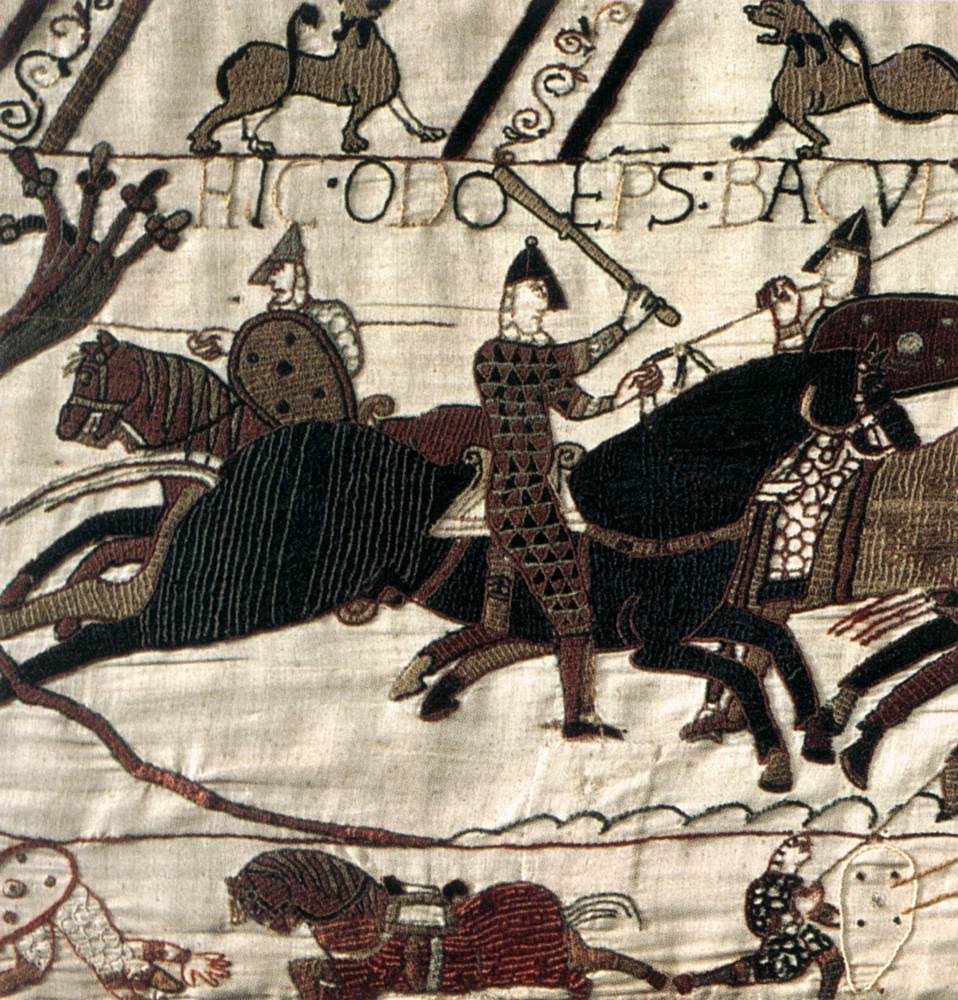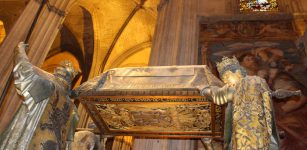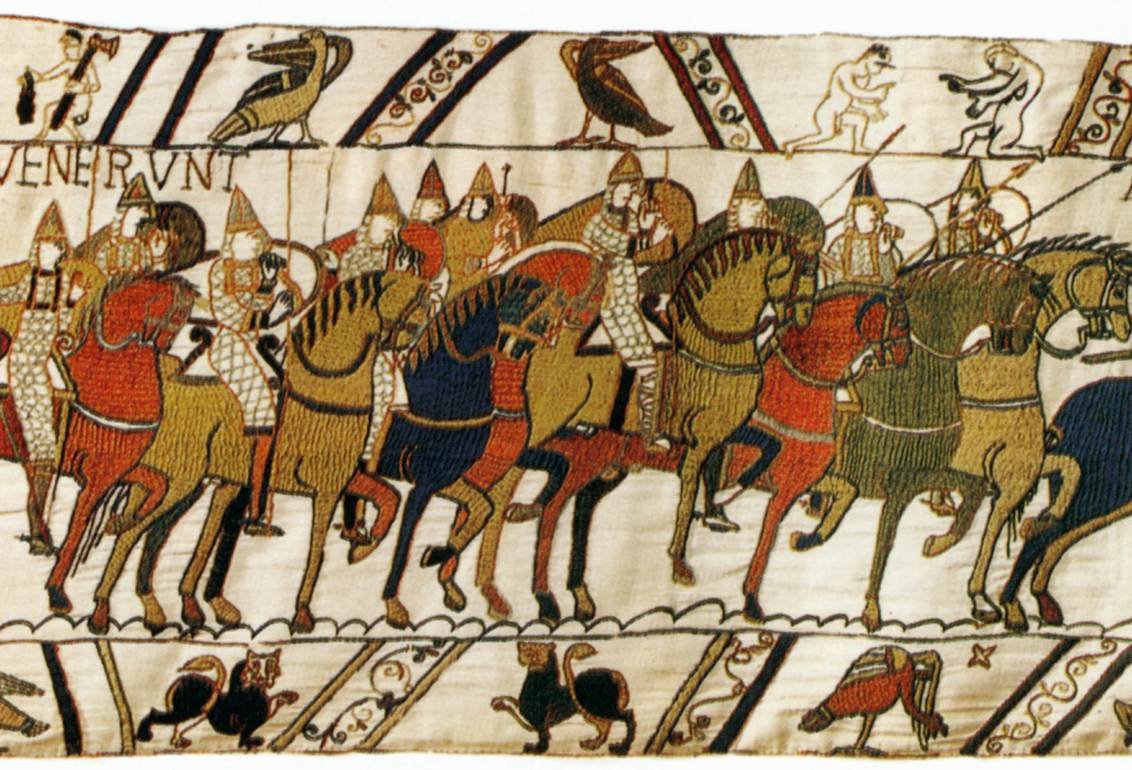The Bayeux Tapestry: One Of The Great Historical Records Of The Middle Ages
A. Sutherland – MessageToEagle.com – The Bayeux Tapestry is an impressive example of Romanesque art depicting the Norman Conquest of England in 1066 by William, duke of Normandy, the historical event that culminated in the famous Battle of Hastings (Oct. 14, 1066).
The Bayeux Tapestry’s vivid action expressed in the scenes strongly resembles a film, but it is more than that; the artifact is important as a source for 11th-century history.
When first referred to (1476), the tapestry was used once a year to decorate the nave of the cathedral in Bayeux, France. There it was “discovered” by the French antiquarian and scholar Bernard de Montfaucon, who published the earliest complete reproduction of it in 1730.
The artwork – made in England, in the 1070s – is an embroidered cloth, about 229 feet (70m), 19.5 inches (49.5 cm) wide and weighs 350 kilos. It consists of fifty-eight embroidered scenes (other sources mention more than 70 scenes) with Latin tituli, embroidered on linen with colored woollen yarns.
With few exceptions, the events are presented in the historically correct sequence, with each of the heroes appearing several times.
Having twice narrowly escaped destruction during the French Revolution, the tapestry was exhibited in Paris at Napoleon’s wish in 1803–04 and thereafter was in civil custody at Bayeux, except in 1871 (during the Franco-German War) and from September 1939 to March 1945 (during World War II).
The borders on the tapestry are full of additional depictions of subplots and legends that constitute a complement to the main scenes.
Towards the end, the vivid action of the Battle of Hastings culminates and the lower border of the tapestry is devoted to dead and wounded soldiers, hordes of bowmen, and the plundering of casualties.

It is easy to imagine all these events because an unknown skilled artist – an unknown English weaver – narrates them visually, leading the eye from one phase to another.
The depictions on the Bayeux Tapestry are handmade with woollen threads and needled onto a strip of linen. They are embroidered in red, yellow, grey, bright green and a darker green, and three shades of blue.
Although the tapestry has been exposed to light and dirt for over nine centuries, the eight colors of woollen thread are still vivid, bright and beautiful.
Many art historians assume that the tapestry was made in southern England (perhaps at the St Augustine monastery in Canterbury) for Odo of Bayeux, bishop and half-brother of William the Conqueror. Almost certainly, the tapestry was hung in the hall of a bishop’s palace.
It is presently exhibited in a special museum in Bayeux, Normandy, France, with a Victorian replica in Reading, Berkshire, England.
Written by – A. Sutherland – MessageToEagle.com Senior Staff Writer
Copyright © MessageToeagle.com All rights reserved. This material may not be published, broadcast, rewritten or redistributed in whole or part without the express written permission of MessageToeagle.com
Expand for referencessource: Britannica
Related Posts
-
 ‘Tonina Chiapas’ Mayan Pyramid In Southern Mexico Is Among The Largest Yet Found
No Comments | Jul 14, 2015
‘Tonina Chiapas’ Mayan Pyramid In Southern Mexico Is Among The Largest Yet Found
No Comments | Jul 14, 2015 -
 Dunino Den: Mysterious And Sacred Ancient Site In Scotland With Enigmatic Rock Faces And Symbols
No Comments | Jan 6, 2017
Dunino Den: Mysterious And Sacred Ancient Site In Scotland With Enigmatic Rock Faces And Symbols
No Comments | Jan 6, 2017 -
 On This Day In History: Albertus Magnus – Medieval Person Of Great Historical Importance Died – On Nov 15, 1280
No Comments | Nov 15, 2016
On This Day In History: Albertus Magnus – Medieval Person Of Great Historical Importance Died – On Nov 15, 1280
No Comments | Nov 15, 2016 -
 Tezcatlipoca: Enigmatic Aztec God Who Looked Inside People’s Hearts And Observed Their Deeds On Earth
No Comments | Jul 23, 2021
Tezcatlipoca: Enigmatic Aztec God Who Looked Inside People’s Hearts And Observed Their Deeds On Earth
No Comments | Jul 23, 2021 -
 Has The Body Of Legendary Pirate Black Sam Finally Been Discovered Off The Coast Of Massachusetts?
No Comments | Feb 17, 2021
Has The Body Of Legendary Pirate Black Sam Finally Been Discovered Off The Coast Of Massachusetts?
No Comments | Feb 17, 2021 -
 Ask And Embla: First Human Pair Created By Powerful God Odin And His Two Brothers
No Comments | Sep 24, 2016
Ask And Embla: First Human Pair Created By Powerful God Odin And His Two Brothers
No Comments | Sep 24, 2016 -
 Why Are The Billions Of Years Old Moeraki Boulders So Perfectly Round?
No Comments | Jun 17, 2013
Why Are The Billions Of Years Old Moeraki Boulders So Perfectly Round?
No Comments | Jun 17, 2013 -
 Tomb Of Christopher Columbus Finally Found But There Is One Problem With His Body
No Comments | Apr 11, 2022
Tomb Of Christopher Columbus Finally Found But There Is One Problem With His Body
No Comments | Apr 11, 2022 -
 Why Were The 4,000-Year-Old Native American Shell Ring Villages Suddenly Abandoned?
No Comments | Mar 5, 2022
Why Were The 4,000-Year-Old Native American Shell Ring Villages Suddenly Abandoned?
No Comments | Mar 5, 2022 -
 Connection Between Alpha Draconis And Egyptians Pyramids Revealed
No Comments | Jan 13, 2020
Connection Between Alpha Draconis And Egyptians Pyramids Revealed
No Comments | Jan 13, 2020


